 WD was first to market with a duty-specific NAS drive when they launched the Red family over two years ago. They’re now onto the third iteration of the 3.5″ drive (we previously review the WD Red Pro), which includes an updated firmware, NASware 3.0, and new larger 5TB and 6TB capacities. The top end 6TB drive of course offers a 50% bump over the previous largest Red and is now the largest NAS HDD on the market as of this review. As part of this release, WD is also supporting 8-bay NAS units with the Reds, up from a recommended 5-bays in the prior generation, creating a grand total of up to 48TB raw within a single NAS unit. That’s a massive amount of data and thus good news for small offices or those with ever-expanding media collections that need to be able to keep up with their data growth.
WD was first to market with a duty-specific NAS drive when they launched the Red family over two years ago. They’re now onto the third iteration of the 3.5″ drive (we previously review the WD Red Pro), which includes an updated firmware, NASware 3.0, and new larger 5TB and 6TB capacities. The top end 6TB drive of course offers a 50% bump over the previous largest Red and is now the largest NAS HDD on the market as of this review. As part of this release, WD is also supporting 8-bay NAS units with the Reds, up from a recommended 5-bays in the prior generation, creating a grand total of up to 48TB raw within a single NAS unit. That’s a massive amount of data and thus good news for small offices or those with ever-expanding media collections that need to be able to keep up with their data growth.
WD was first to market with a duty-specific NAS drive when they launched the Red family over two years ago. They’re now onto the third iteration of the 3.5″ drive (we previously review the WD Red Pro), which includes an updated firmware, NASware 3.0, and new larger 5TB and 6TB capacities. The top end 6TB drive of course offers a 50% bump over the previous largest Red and is now the largest NAS HDD on the market as of this review. As part of this release, WD is also supporting 8-bay NAS units with the Reds, up from a recommended 5-bays in the prior generation, creating a grand total of up to 48TB raw within a single NAS unit. That’s a massive amount of data and thus good news for small offices or those with ever-expanding media collections that need to be able to keep up with their data growth.
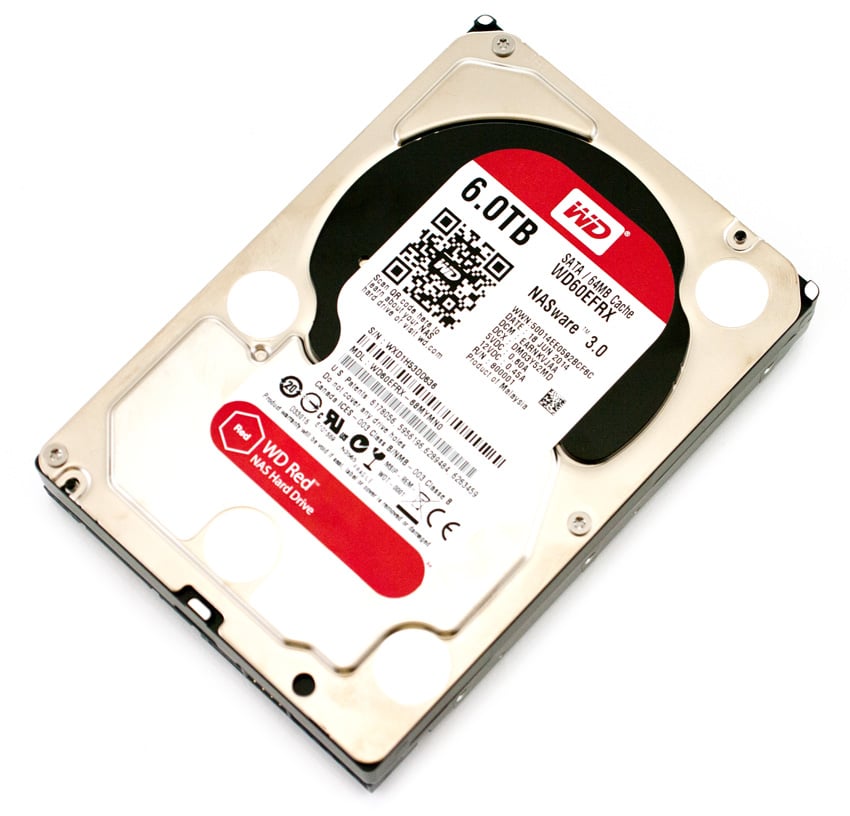
Fundamentally, NASware 3.0 is architected to improve reliability and system performance as well as to reduce customer downtime and simplify the integration process. WD’s new NASware is even more optimized for NAS environments and is more compatible with larger NAS systems (6 to 8), allowing for a maximum of 48TB of storage space if eight of the new 6TB Red drives are used. The Red drives were made to thrive in SMB environments while consuming a minimal amount of energy, producing a minimal amount of sound and significantly lower operating temperatures within small NAS environments. WD also designed the Red NAS HDDs for ultimate compatibility and performance with the My Cloud , the 2-bay My Cloud EX2, and the 4-bay My Cloud EX4 external storage solutions.
The WD Red 6TB goes for approximately $299.00 and includes a 3-year warranty with a dedicated support line. Our review consists of 8 x WD Red 6TB NAS HDDs configured in a Synology DS1813+.
Editorial note: The original 6TB Reds that were sent for review exhibited performance anomalies that required the drives be replaced by WD. WD found the issue and solved it, making early reviews of the 6TB drives invalid. Our review was put on hold as waiting for the final product was more important than going to market with inaccurate data.
WD Red Specifications
- Capacities
- 5TB (WD50EFRX)
- 6TB (WD60EFRX)
- Interface: SATA 6Gb/s
- Form Factor: 3.5in
- RPM: 5400
- Platters: 1.2TB x5 (6TB)
- Cache: 64MB
- Advanced Format
- Native command queuing
- RoHS compliant
- Data transfer rate (max)
- Buffer to host 6Gb/s
- Power Management
- 12VDC-/+10% (A, peak): 1.9
- Temperature (°C)
- Operating: 5 to 60
- Non-operating: -40 to 70
- Shock (Gs)
- Operating (2ms, read/write): 30
- Operating (2ms, read): 65
- Non-operating (2ms): 300
- Acoustics (dBA)
- Idle: 25
- Seek (average): 28
- Physical Dimensions
- Height (in/mm, max) 1.028/26.1
- Length (in/mm, max) 5.787/147
- Width (in/mm, ± .01in) 4/101.6
- Weight (lb/kg, ± 10%) 1.66/0.68
Design and Build
The WD Red 6TB looks identical to the Pro iteration of the drive. It has a basic 3.5″ HDD layout, with a silver metal lid on the top (along with red trimmed branding) and black molded plastic and metal on the back. The front sticker of the WD Red contains information pertaining to its capacity, model number, and specifications.
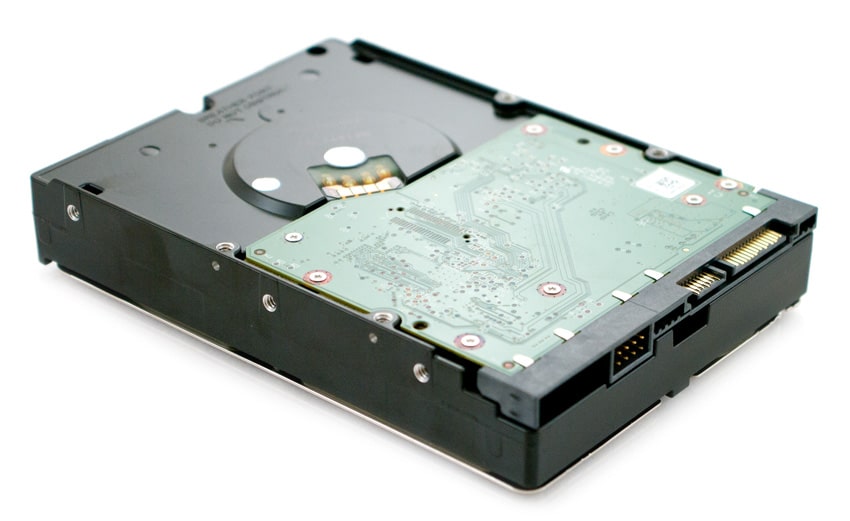
Three mounting screw holes are located on each side of the WD Red, which does give it more mounting flexibility than other drives with a two screw design.
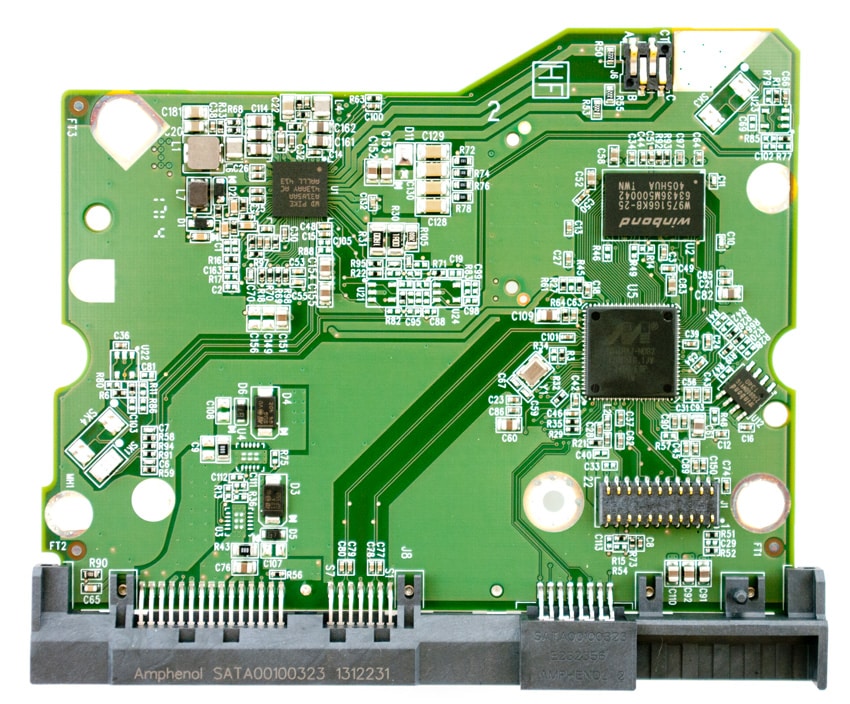
With the PCB removed, you will see the popular Marvell controller, which found on numerous other WD 2.5″ and 3.5″ hard drives.
Testing Background and Comparables
- 2 x Intel Xeon X5650 (2.66GHz, 12MB Cache)
- Windows Server 2008 Standard Edition R2 SP1 64-Bit running on VMware ESXi 5.1
- Intel 5500+ ICH10R Chipset
- Memory – 32GB (4 x 8GB) 1333Mhz DDR3 Registered RDIMMs
Netgear ProSafe GS752TXS Smart 52-port Switch
- 48 1GbE Ports, 4 10GbE SFP+ Uplink Ports
- 176Gbps Aggregate Bandwidth
- Enterprise Synthetic Workload Analysis
Our shared storage benchmark process preconditions each NAS into steady-state with the same workload the device will be tested with under a heavy load of 16 threads with an outstanding queue of 16 per thread, and then tested in set intervals in multiple thread/queue depth profiles to show performance under light and heavy usage. Since HDD-based shared storage reaches its rated performance level very quickly, we only graph out the main sections of each test.
Preconditioning and Primary Steady State Tests:
- Throughput (Read+Write IOPS Aggregate)
- Average Latency (Read+Write Latency Averaged Together)
- Max Latency (Peak Read or Write Latency)
- Latency Standard Deviation (Read+Write Standard Deviation Averaged Together)
Our Enterprise Synthetic Workload Analysis includes two profiles based on real-world tasks. These profiles have been developed to make it easier to compare to our past benchmarks as well as widely-published values such as max 4k read and write speed and 8k 70/30, which is commonly used for enterprise drives.
- 4k
- 100% Read or 100% Write
- 100% 4k
- 8k 70/30
- 70% Read, 30% Write
- 100% 8k
- 8k (Sequential)
- 100% Read or 100% Write
- 100% 8k
- 128k (Sequential)
- 100% Read or 100% Write
- 100% 128k
Performance
In the following section of this review, we will show the performance of both iSCSI and CIFS configurations of the new 3.5″ WD Red 6TB HDDs. WD supplied StorageReview with 8 samples of their new HDDs, which we configured in RAID10 in our Synology DiskStation DS1813+.
We will be including the following drives as comparables in the same DS1813+ configuration:
- WD Red (4TB, 5,400RPM)
- WD Se (4TB, 7,200RPM)
- Seagate NAS (4TB, 5,900RPM)
- HGST NAS (4TB, 7,200RPM)
- HGST 7K4000 (4TB, 7,200RPM)
- Seagate ES.3 (3TB, 7,200RPM)
- WD Red Pro (4TB, 7,200RPM)
In our first test measuring 4K random performance the WD Red 6TB drive showed an the strongest performance for a 5k RPM HDD in both read and write functions with 1,922 IOPS and 1,106 IOPS, respectively. The Seagate ES.3 3TB was the top performer in read functions (2,360 IOPS) and the second best performer in write functions (1,480 IOPS). The WD Red Pro 4TB was the top write performer with 1,515 IOPS.
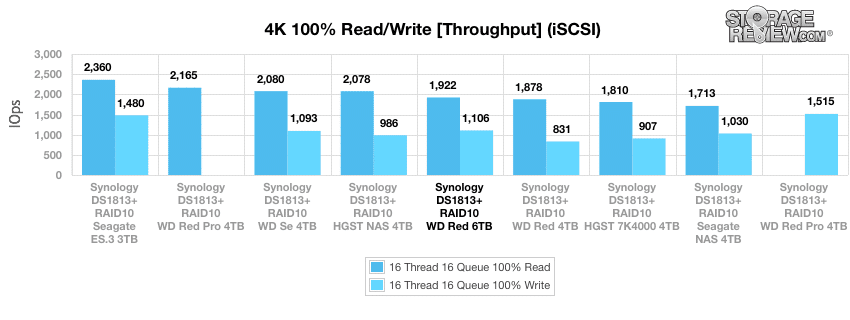
The WD Red 6TB drive was lower in the pack in the CIFS read performance, but performed well in write throughput (1,875 IOPS and 420 IOPS in write and read, respectively). The WD Red Pro 4TB was the top performer in write functions with 2,401 IOPS and the top performer in read functions was the HGST 7K4000 4TB with 566 IOPS.
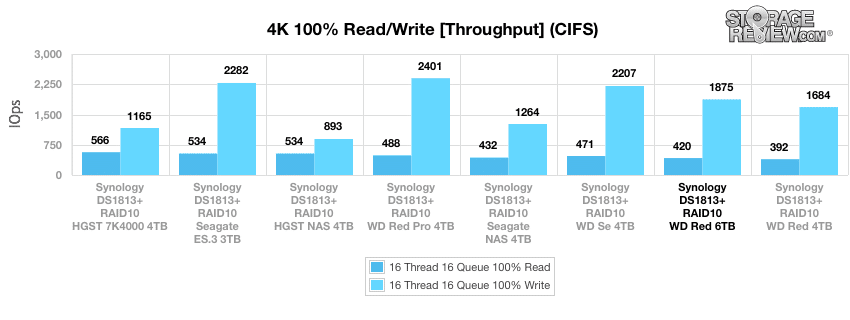
The results of the average latency benchmark in the iSCSI test was very similar to those of the throughput benchmark; the WD Red 6TB drive was average overall, but strong vs 5k NAS HDDs in both read and write functions with 133.2ms and 231.2ms, respectively. The WD Red 4TB was the top performer in write functions with 308.0ms and the Seagate NAS 4TB was the top performer in read functions with 149.4ms.
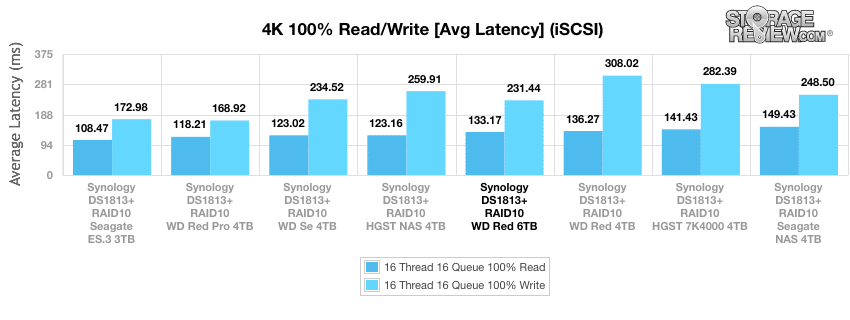
The WD Red 6TB drive was the second slowest read performer (608.8ms) of all of the drives tested and had an average write performance (136.6ms). The WD Red Pro 4TB had the fastest write performance (106.6ms) and the HGST 7K4000 4TB had the fastest read performance (451.8ms).
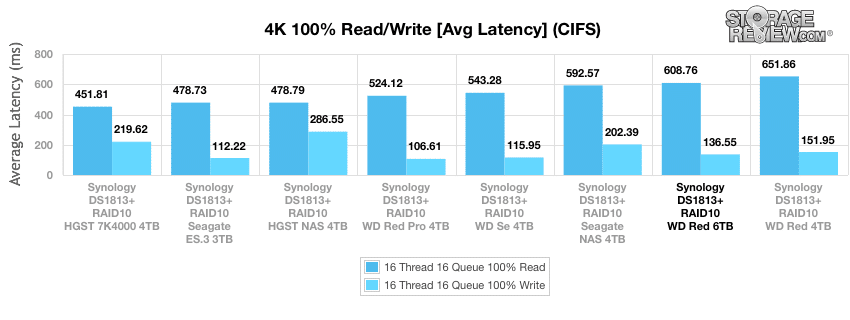
The WD Red 6TB performed average in the max latency benchmark (iSCSI) with 1,253ms and 1,850ms in read and write, respectively. The top performer in read functions was the Seagate ES.3 3TB (987.8ms) and the top performer in write functions was the WD Red Pro 4TB (1,037ms).
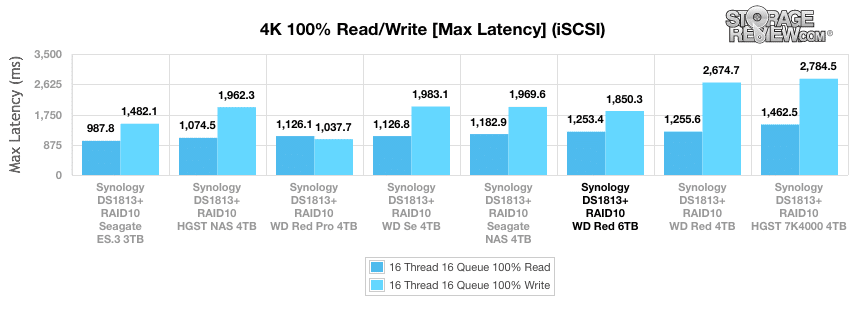
The WD Red 6TB drive performed relatively well in read functions (2,464ms) in our CIFS test, outpacing the WD Red Pro 4TB, Seagate NAS 4TB, WD Red 4TB, and WD Se 4TB. Its write performance measured 1,213ms. The top performers in this benchmark were the HGST NAS 4TB for read (2,306ms) and the WD Red Pro 4TB for write (919ms).
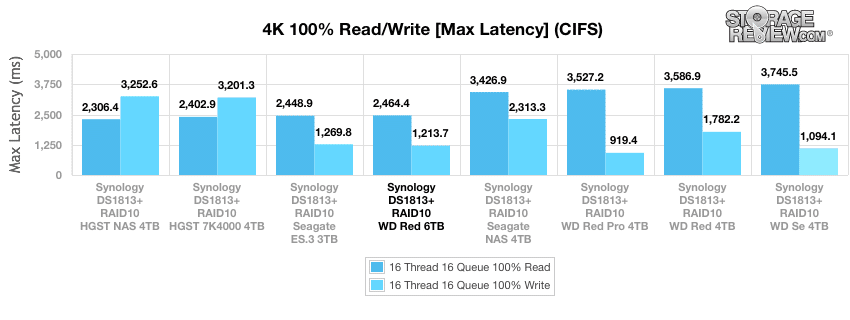
The top spot for read performance in the benchmark went to the Seagate ES.3 3TB (83.7ms). The WD Red 6TB performed very well, achieving the second best read value (98.6ms) and the third best write value (279.5ms). The WD Red Pro 4TB earned the top spot for write functions with 189.3ms.
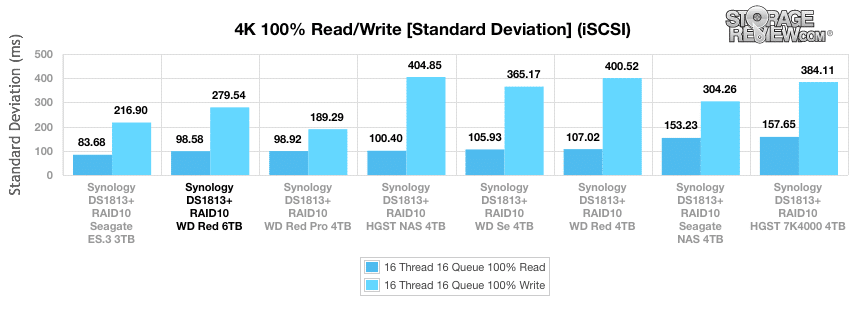
The results were similar in a CIFS environment; the WD Red 6TB performed well overall with the third best read performance (439.3ms) and an above average write performance (147.8ms). The HGST 7K4000 4TB was the most consistent drive in read functions with a standard deviation of 352.1ms and the WD Red Pro 4TB was the most consistent drive in write functions with a standard deviation of 107.2ms.
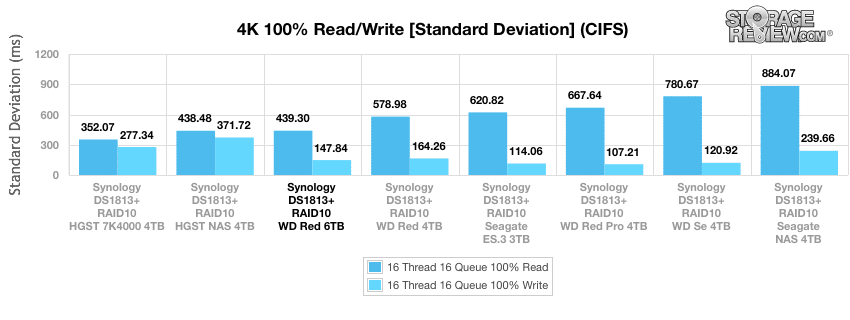
Our next test shifts focus from a pure 4K random read or write scenario to a mixed 8K 70/30 workload where we will show how performance scales in a setting from 2T/2Q up to 16T/16Q. The WD Red Pro 4TB and Seagate ES.3 3TB were neck and neck for the top spot through the duration of this benchmark. The WD Red 6TB drive was generally an average performer overall, but quite strong against the other 5K NAS HDD comparables.
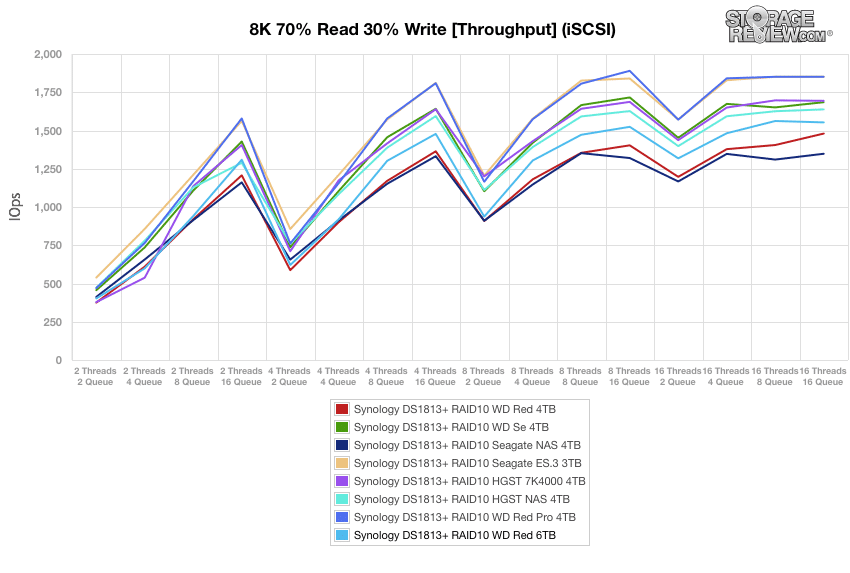
The Seagate ES.3 3TB was once again a top performer, along with the HGST 7K4000 4TB. The WD Red 6TB, along with the WD Red 4TB and Seagate NAS 4TB, was in the bottom three for this benchmark with the 6TB Red leading the 5K group.
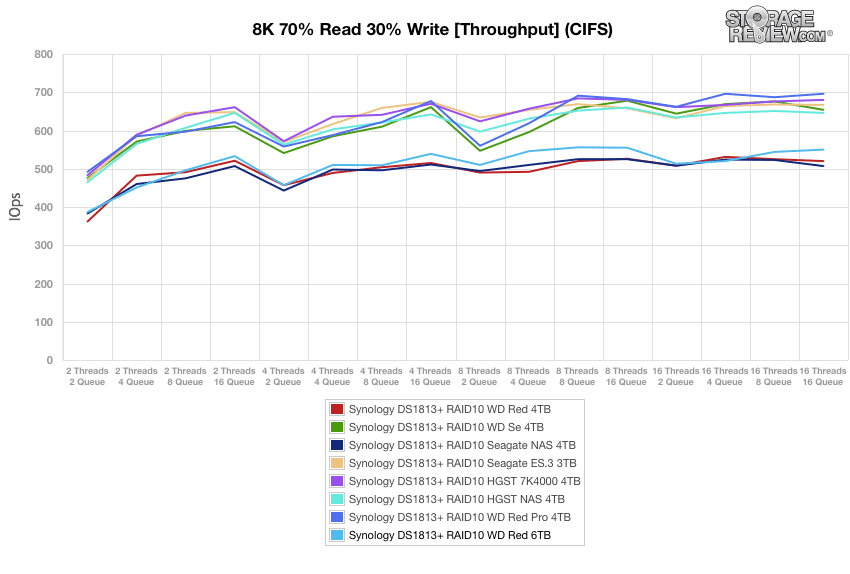
The WD Red Pro 4TB was the top performer in the average latency benchmark, followed by the Seagate ES.3 3TB. The WD Red 6TB was average compared to the other drives, and the Seagate NAS 4TB was the slowest drive tested.
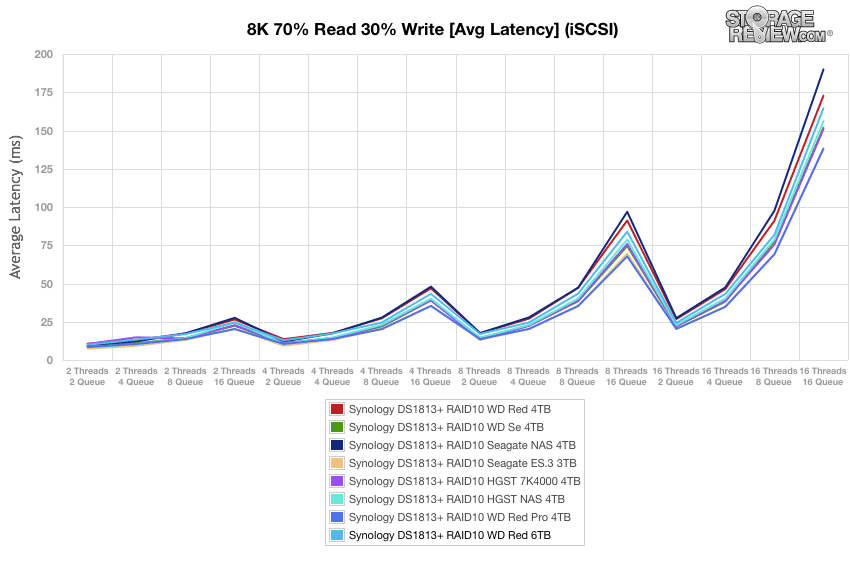
The results of the CIFS configured average latency benchmark were very similar to the results of the CIFS configured throughput benchmark; the WD Red Pro 4TB and the Seagate ES.3 3TB were the top performers and the WD Red 6TB was among two other drives (the WD Red 4TB and Seagate NAS 4TB) on the slower end.
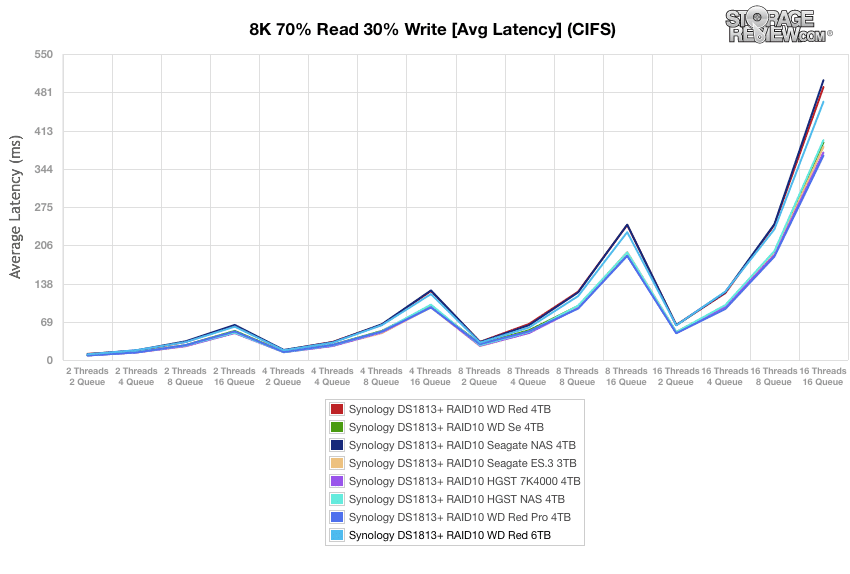
The WD Red 6TB performed quite well here; it, along with the WD Red Pro 4TB and WD Se 4TB, was a top performer in this benchmark. The Seagate NAS 4TB and HGST 7K4000 4TB held up the bottom end as the slowest drives.
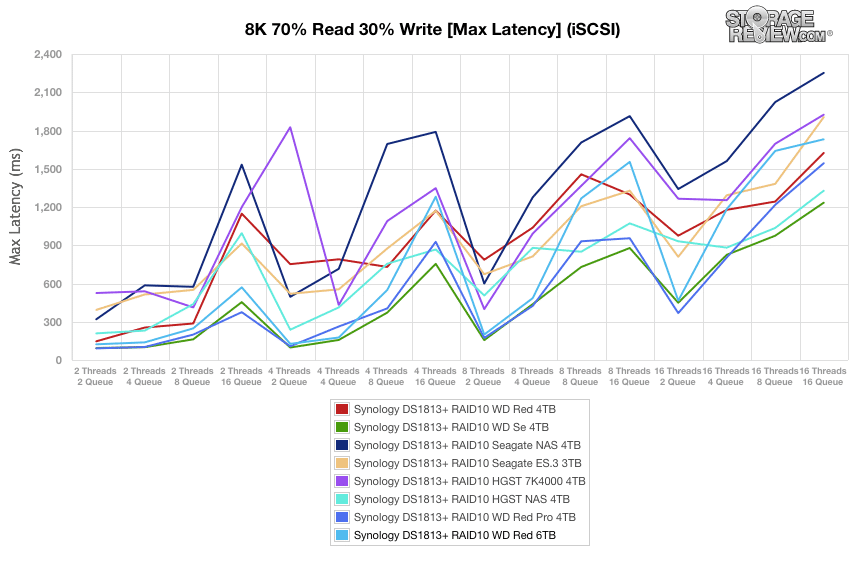
All of the drives were scattered for all but the end of this benchmark, at which point the WD Red 6TB drive was the fastest, followed by the WD Red 4TB. The WD Red Pro 4TB and Seagate NAS 4TB were the slowest drives tested.
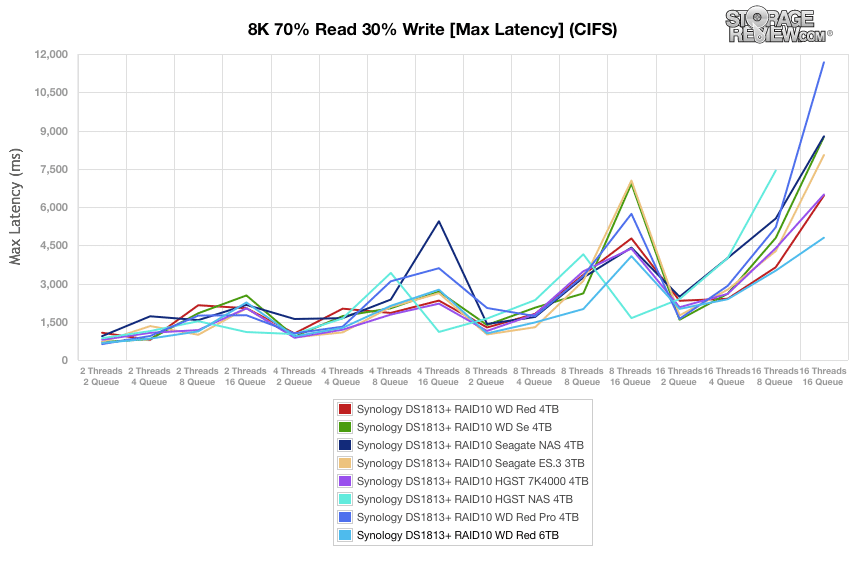
The WD Red 6TB drive performed slightly above average in this test. The WD Red Pro 4TB and WD Se 4TB were the top performers and the Seagate NAS 4TB was the slowest drive.
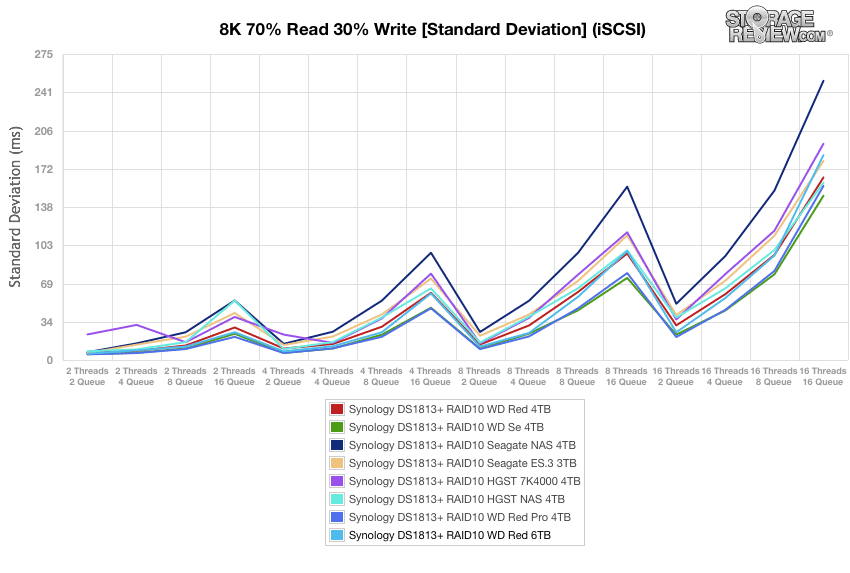
In our CIFS test, the WD Red 6TB performed quite well; it was the most consistent drive tested, followed closely by the HGST 7K4000 4TB. The Seagate NAS 4TB and WD Se 4TB seemed to be the least consistent drives, but the latter had some competitive consistency early in the benchmark.
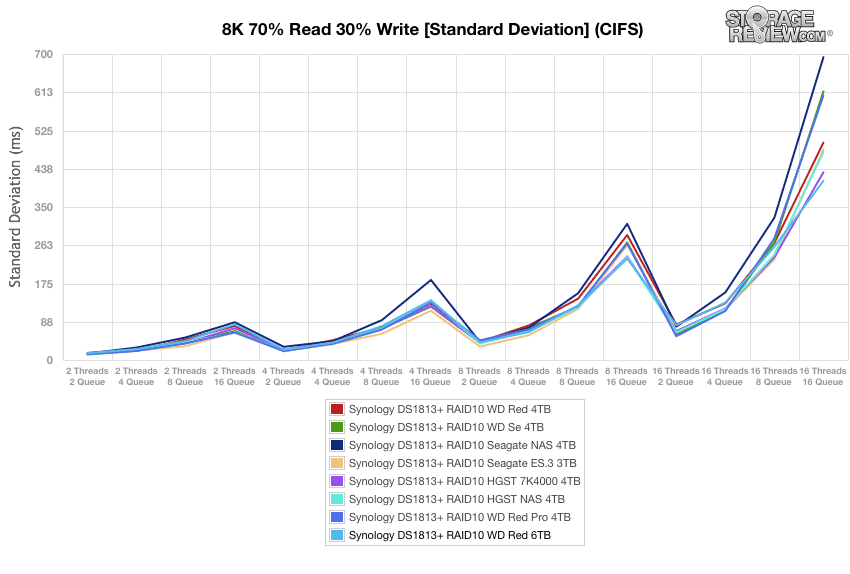
While the first part of the workload comparison focused on random workload performance, our second half measures small and large-block sequential transfer speeds. In this benchmark, the WD Red 6TB performed very well in read functions (9,654 IOPS) and was the fastest drive in terms of write functions (14,336 IOPS). The Seagate ES.3 3TB was the fastest read performer with 15k IOPS but all of the other drives were well under 10k IOPS and the WD Red 6TB was the second fastest read performer. The Seagate NAS 4TB was the slowest drive in both read and write functions with 6,664 IOPS and 4,027 IOPS, respectively.
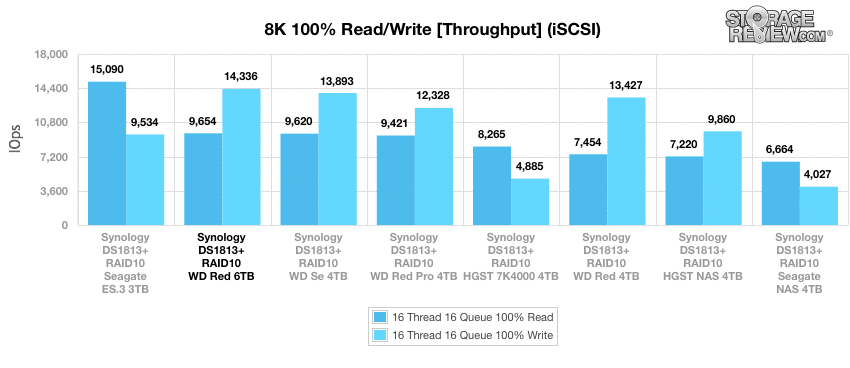
Switching to the CIFS protocol, the WD Red 6TB was again the fastest writing drive with 23,695 IOPS. However, it was the second slowest drive with respect to read speed with 28k IOPS, only beating out the WD Red Pro 4TB. The WD Se 4TB was the fastest reading drive with 33,619 IOPS.
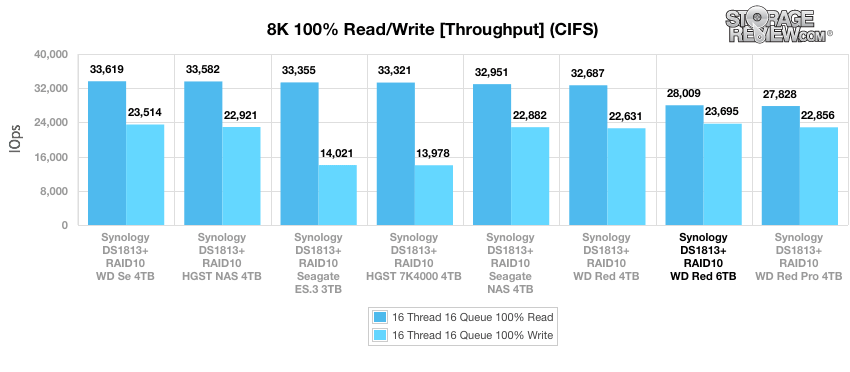
Our last test looks at large-block sequential performance, the Seagate ES.3 3TB dominated the read performance with 248MB/s, almost 75MB/s higher than the next fastest drive (the Seagate NAS 4TB). The WD Red 6TB didn’t really thrive under these conditions, performing averagely in both read and write (146MB/s and 70MB/s, respectively).
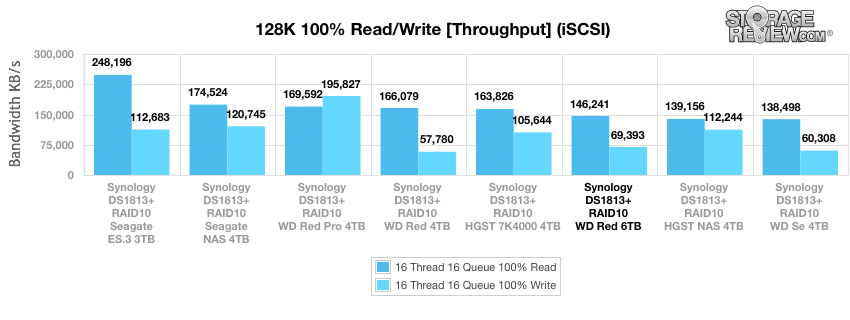
The WD Red 6TB and WD Red Pro 4TB both performed relatively poorly in terms of read; all of the other drives were in the 330MB/s range but the WD Red 6TB and WD Red Pro 4TB had speeds of 231MB/s and 209MB/s, respectively. The WD Red 6TB was slightly below average in terms of write performance with 221MB/s.
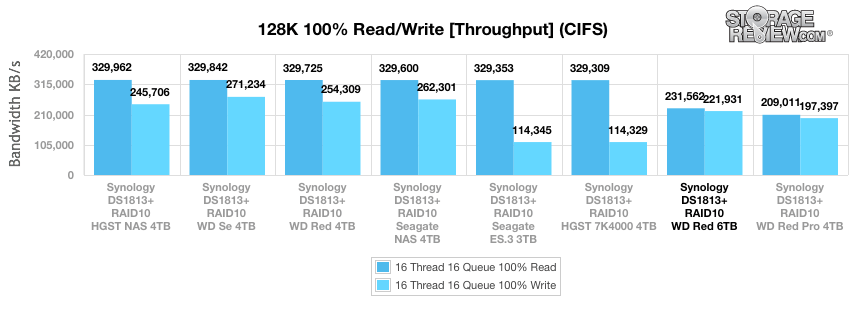
Conclusion
WD’s Red 6TB HDD is the newest installment of the Red family and is currently the largest NAS-specific HDD available on today’s market. The WD Red is of a 3.5 Inch, 1.2TB 5-platter form factor and is designed specifically for SOHO and consumer 1-8 bay NAS systems (e.g. WD’s My Cloud and My Book storage solutions, and Synology NAS) that require compatible and extended storage. WD’s new drive features the updated NASware 3.0 as well as updated firmware, technologies of which that specifically improve its compatibility and performance within NAS devices.
When looking at the 6TB WD Red’s performance, it posted strong performance when compared to other WD drives or comparable 5K RPM NAS HDDs. Compared to all drive in the NAS and near-line SATA category, many of which offer 7K RPM spindle speeds the 6TB Red still performed well or ranked near middle. This isn’t too surprising since random access performance for example depends greatly on spindle speed. With the primary selling point of this new drive being its high capacity, WD managed to do a heck of a job keeping things in check performance wise and not losing performance in most areas against the previous-generation 4TB Red.
Overall the 5TB and 6TB Reds offer a great step forward for those with expanding media sets. They also help the value proposition of the NAS market at large, meaning a standard 4-bay unit that topped out at 16TB raw with NAS-specific drives prior, can now support 24TB. WD has made great strides in performance and boosted top end capacity by 50%, what’s not to like? The Reds have clearly re-asserted themselves as the best high-capacity NAS drive for the consumer/SOHO space.
Pros
- Largest NAS HDD available
- Great 8K performance
- Upgraded NASware features
Cons
- Trade-off in random access performance with slower spindle speed
The Bottom Line
For those looking maximize their storage capabilities in a NAS, the WD Red 6TB drives are a great option. Not only to they perform very well, but they offer 2TB more capacity than anything else currently in the market on a third generation platform that has been battle-tested.
